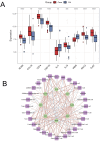Identification of immune microenvironment subtypes and clinical risk biomarkers for osteoarthritis based on a machine learning model
- PMID: 39484639
- PMCID: PMC11524973
- DOI: 10.3389/fmolb.2024.1376793
Identification of immune microenvironment subtypes and clinical risk biomarkers for osteoarthritis based on a machine learning model
Abstract
Background: Osteoarthritis (OA) is a degenerative disease with a high incidence worldwide. Most affected patients do not exhibit obvious discomfort symptoms or imaging findings until OA progresses, leading to irreversible destruction of articular cartilage and bone. Therefore, developing new diagnostic biomarkers that can reflect articular cartilage injury is crucial for the early diagnosis of OA. This study aims to explore biomarkers related to the immune microenvironment of OA, providing a new research direction for the early diagnosis and identification of risk factors for OA.
Methods: We screened and downloaded relevant data from the Gene Expression Omnibus (GEO) database, and the immune microenvironment-related genes (Imr-DEGs) were identified using the ImmPort data set by combining weighted coexpression analysis (WGCNA). Functional enrichment of GO and Kyoto Encyclopedia of Genes and Genomes (KEGG) were conducted to explore the correlation of Imr-DEGs. A random forest machine learning model was constructed to analyze the characteristic genes of OA, and the diagnostic significance was determined by the Receiver Operating Characteristic Curve (ROC) curve, with external datasets used to verify the diagnostic ability. Different immune subtypes of OA were identified by unsupervised clustering, and the function of these subtypes was analyzed by gene set enrichment analysis (GSVA). The Drug-Gene Interaction Database was used to explore the relationship between characteristic genes and drugs.
Results: Single sample gene set enrichment analysis (ssGSEA) revealed that 16 of 28 immune cell subsets in the dataset significantly differed between OA and normal groups. There were 26 Imr-DEGs identified by WGCNA, showing that functional enrichment was related to immune response. Using the random forest machine learning model algorithm, nine characteristic genes were obtained: BLNK (AUC = 0.809), CCL18 (AUC = 0.692), CD74 (AUC = 0.794), CSF1R (AUC = 0.835), RAC2 (AUC = 0.792), INSR (AUC = 0.765), IL11 (AUC = 0.662), IL18 (AUC = 0.699), and TLR7 (AUC = 0.807). A nomogram was constructed to predict the occurrence and development of OA, and the calibration curve confirmed the accuracy of these 9 genes in OA diagnosis.
Conclusion: This study identified characteristic genes related to the immune microenvironment in OA, providing new insight into the risk factors of OA.
Keywords: biomarker; early diagnosis; immune microenvironment; machine learning; osteoarthritis.
Copyright © 2024 Li, Shen, Liu, Yuan, Liu, Li, Zhang, Du and Liu.
Conflict of interest statement
The authors declare that the research was conducted in the absence of any commercial or financial relationships that could be construed as a potential conflict of interest.
Figures










Similar articles
-
Identification of aging-related biomarkers and immune infiltration characteristics in osteoarthritis based on bioinformatics analysis and machine learning.Front Immunol. 2023 Jul 12;14:1168780. doi: 10.3389/fimmu.2023.1168780. eCollection 2023. Front Immunol. 2023. PMID: 37503333 Free PMC article.
-
Developing the new diagnostic model by integrating bioinformatics and machine learning for osteoarthritis.J Orthop Surg Res. 2024 Dec 18;19(1):832. doi: 10.1186/s13018-024-05340-4. J Orthop Surg Res. 2024. PMID: 39695788 Free PMC article.
-
Multi-omics characterization of macrophage polarization-related features in osteoarthritis based on a machine learning computational framework.Heliyon. 2024 Apr 27;10(9):e30335. doi: 10.1016/j.heliyon.2024.e30335. eCollection 2024 May 15. Heliyon. 2024. PMID: 38774079 Free PMC article.
-
Identification of a novel disulfidptosis-related gene signature in osteoarthritis using bioinformatics analysis and experimental validation.Sci Rep. 2025 Jan 8;15(1):1339. doi: 10.1038/s41598-025-85569-z. Sci Rep. 2025. PMID: 39779817 Free PMC article.
-
Identification of susceptibility modules and hub genes of osteoarthritis by WGCNA analysis.Front Genet. 2022 Nov 18;13:1036156. doi: 10.3389/fgene.2022.1036156. eCollection 2022. Front Genet. 2022. PMID: 36468029 Free PMC article.
References
LinkOut - more resources
Full Text Sources
Miscellaneous

